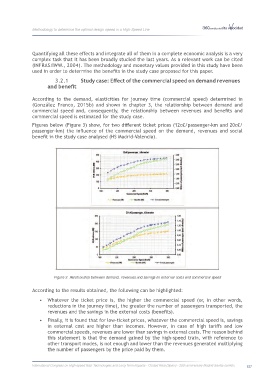Page 539 - 360.revista de Alta Velocidad - Nº 6
P. 539
Methodology to determine the optimal design speed in a High-Speed Line
Quantifying all these effects and integrate all of them in a complete economic analysis is a very
complex task that it has been broadly studied the last years. As a relevant work can be cited
(INFRAS/IWW., 2004). The methodology and monetary values provided in this study have been
used in order to determine the benefits in the study case proposed for this paper.
3.2.1 Study case: Effect of the commercial speed on demand revenues
and benefit
According to the demand, elasticities for journey time (commercial speed) determined in
(González Franco, 2015b) and shown in chapter 3, the relationship between demand and
commercial speed and, consequently, the relationship between revenues and benefits and
commercial speed is estimated for the study case.
Figures below (Figure 3) show, for two different ticket prices (12c€/passenger-km and 20c€/
passenger-km) the influence of the commercial speed on the demand, revenues and social
benefit in the study case analysed (HS Madrid-Valencia).
Figure 3. Relationship between demand, revenues and savings on external costs and commercial speed
According to the results obtained, the following can be highlighted:
• Whatever the ticket price is, the higher the commercial speed (or, in other words,
reductions in the journey time), the greater the number of passengers transported, the
revenues and the savings in the external costs (benefits).
• Finally, it is found that for low-ticket prices, whatever the commercial speed is, savings
in external cost are higher than incomes. However, in case of high tariffs and low
commercial speeds, revenues are lower than savings in external costs. The reason behind
this statement is that the demand gained by the high-speed train, with reference to
other transport modes, is not enough and lower than the revenues generated multiplying
the number of passengers by the price paid by them.
International Congress on High-speed Rail: Technologies and Long Term Impacts - Ciudad Real (Spain) - 25th anniversary Madrid-Sevilla corridor 537

